I have a general question I thought you or a reader could help me with. Since you eat most of your meals at home and always have, how did keep your pantry and frig stocked? I am forever short what I would need and going to the store several times each week won’t work for me. Do you have any guidance on that subject?
-Maryanne
I’m guessing this is one of those questions that will have a different answer depending on who you ask. So, it’s a perfect one to do an Ask The Readers post on!
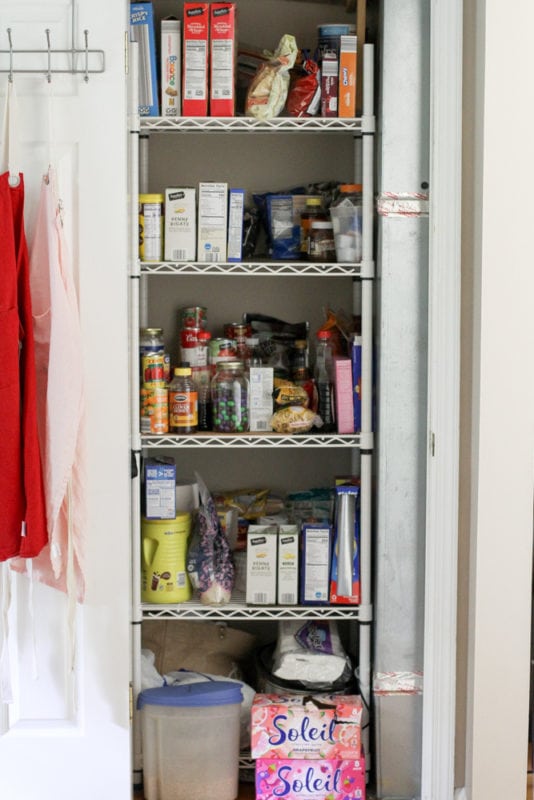
my current pantry
Even if I was the only source you asked, my answer to this question would have been different at earlier stages of my life than it is now. Life is in a perpetual state of flux, and things like my pantry/shopping routines have needed to adjust.
For instance, in 2020, when I was feeding five people three meals a day during the height of Covid, I managed differently than I do now, with a household of two college students.
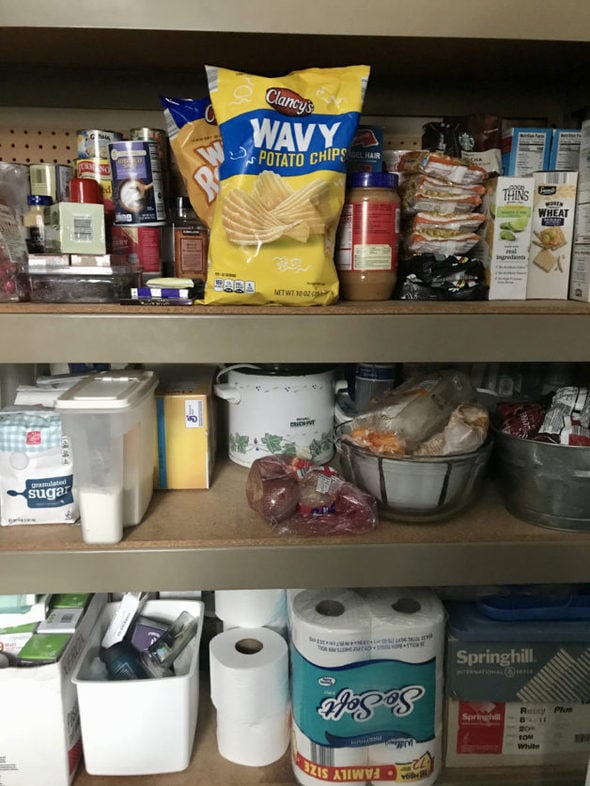
my “pantry” at my last house, which was just some shelves in the laundry room
I’ll tell you about my current routines, and then I’ll ask readers to share theirs. That way you’ll get a nice sampling of the ways we all tackle this challenge!
For anyone just joining, I’m a single (divorced) full-time nursing school student with a part-time job at the hospital, and I’m feeding myself + my 18-year-old daughter (also a college student with a part-time job).
I fly by the seat of my pants a lot more than I did when I fed a bigger household, but even so, I do have some pantry routines that help me.
Produce
I get a Hungry Harvest box delivered every other week, largely because it encourages me to eat more produce. If my fridge is stocked with produce, I will usually eat most of it.
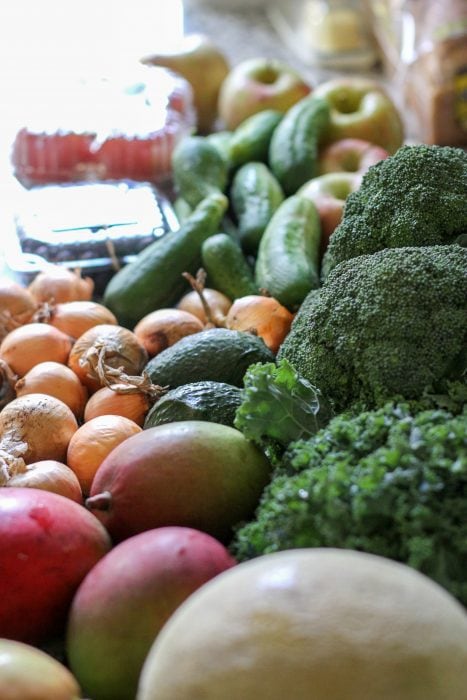
In addition to the Hungry Harvest box, I buy pretty much the same produce each week: grape tomatoes, cucumbers, bananas, berries, apples, and oranges.
Dairy/Eggs
This is another area where things don’t vary much. I keep cottage cheese, eggs, a variety or two of cheese, and a gallon of milk on hand.
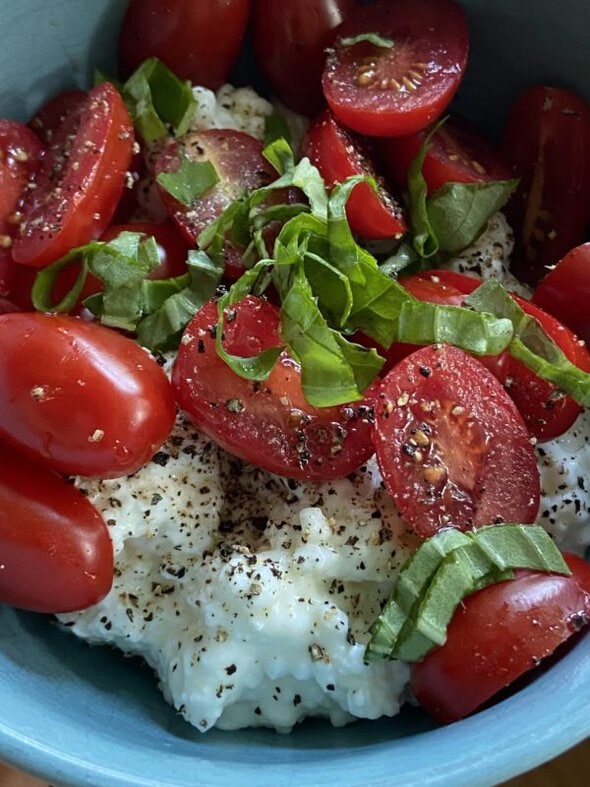
I usually have some jars of homemade yogurt in my fridge as well.
Oh, and half and half for my coffee.
I buy extra butter and keep it in my chest freezer so that we always have it on hand.
Breads
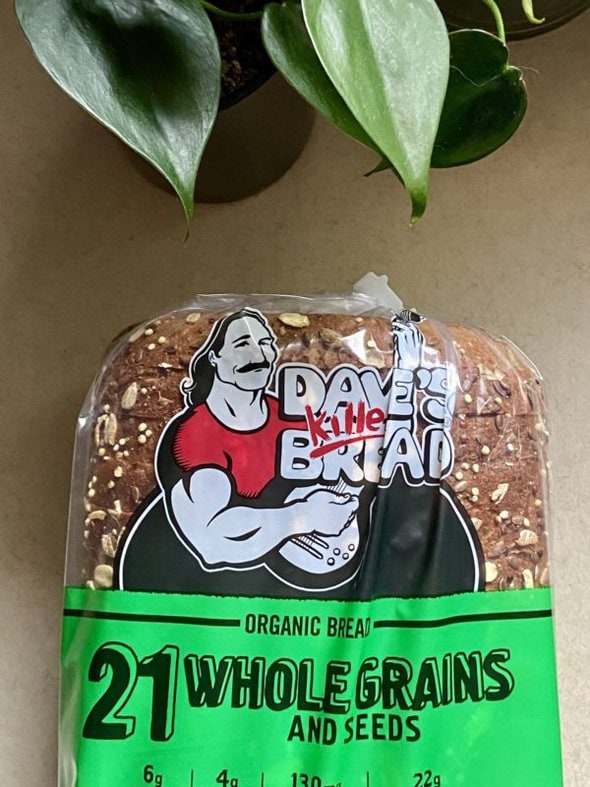
I keep 100% whole wheat sandwich bread and Dave’s Killer Bread around all the time; I buy them in double packs at Sam’s Club and keep the extras in the freezer.

I also usually have some bagels here for Zoe; I buy a package, freeze some of them, and keep the others out on the counter for her.
I buy tortillas, but I usually store those in the freezer since we don’t eat them super regularly.
Canned/Dry Goods
I keep some basics around, like a big bag of rice, canned beans, canned tomatoes, canned tuna, pancake syrup, peanut butter, honey, tea, oatmeal, coffee, sugar, and flour, and I just add these things to my shopping list when I use them up.
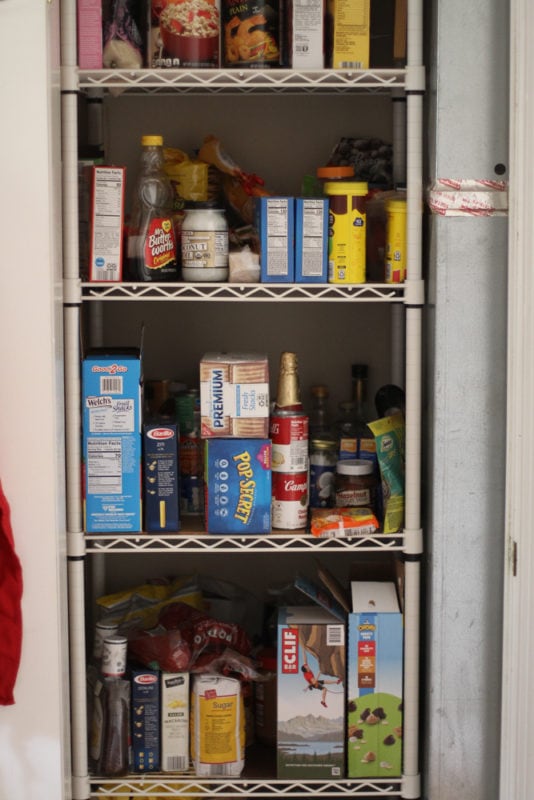
The same goes for items like spices or condiments (BBQ sauce, mustard).
I also keep a box of Rx bars here and some other high-protein granola bars, plus seedy flatbread crisps from Trader Joe’s, and a box of Aldi’s version of Triscuits.
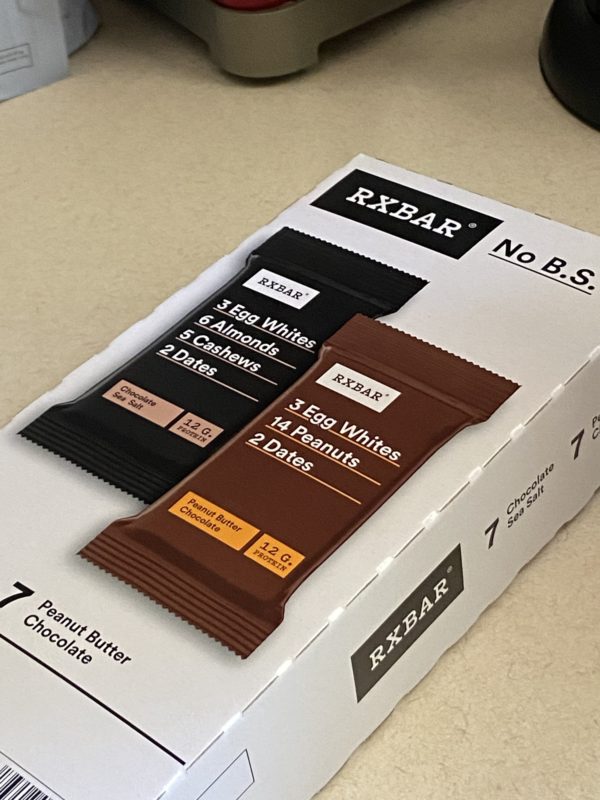
I keep some convenience foods on hand that Zoe likes too, such as some canned soup, ramen, and boxed mac and cheese.
Meat
I usually keep some meats in my chest freezer (a bag of shrimp, a few packages of chicken, some ground beef) so that I have some basics available for building a meal.
Miscellaneous
When I make a grocery list, I include the pantry items that I need to restock, plus the perishable foods I need. To help me keep track of what staples I need to replace, I keep a simple list on the side of my fridge and I write things down there when they occur to me.
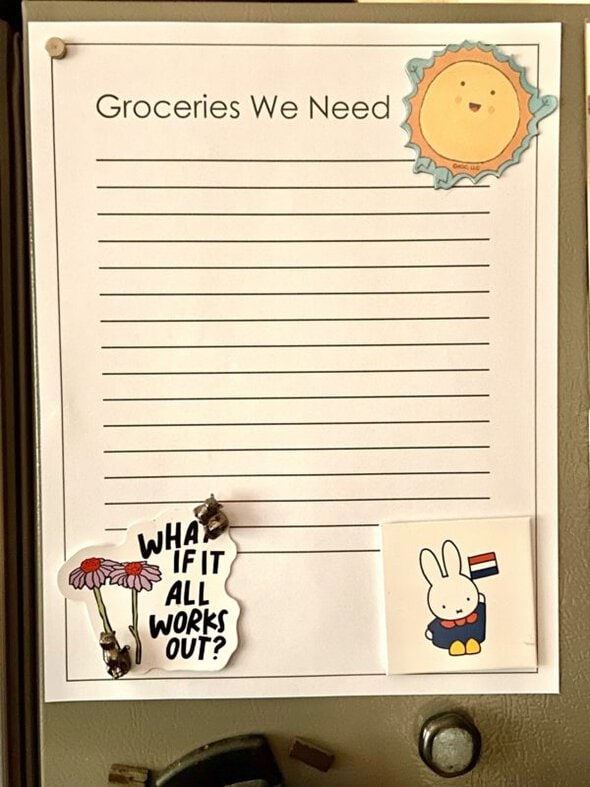
You can obviously use any list you like (a piece of scrap paper works!), but if you want to print one like mine, here’s a printable PDF version of the one I made.
All I need to add to my weekly grocery list are any extras that a particular meal that week might need, like a special sauce/spice/type of produce.
And even if I don’t do any planning, since I have some pretty good basics in my fridge/freezer/pantry I can usually pull together a decent breakfast, lunch, or dinner meal.
Concluding Thoughts
At this stage of my life, some keys are:
- keeping plenty of versatile staples around
- mostly buying foods that have a long shelf-life/fridge-life (romaine lettuce vs. spinach, for example)
- using my chest freezer
(Scroll to the end of this post for some of my thoughts on the value of a chest freezer even for a small household.)
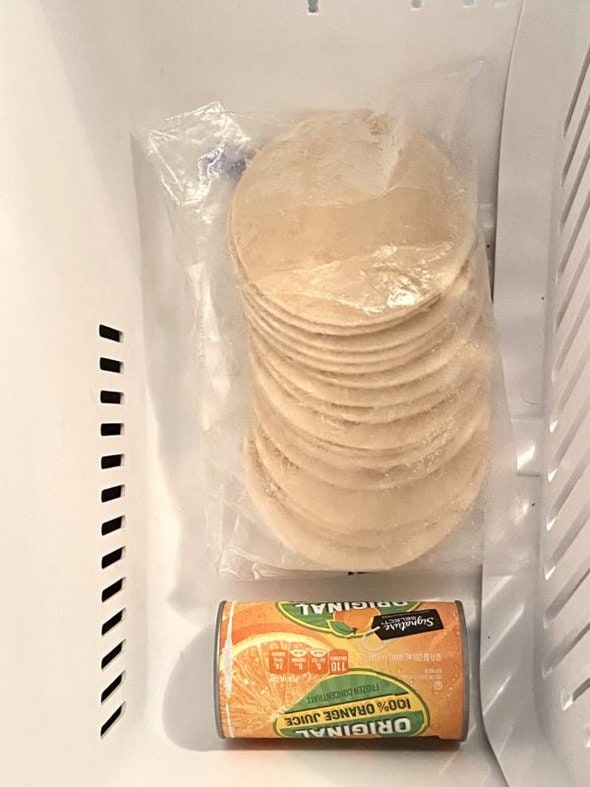
Also, being flexible really helps. I usually have a somewhat loose plan for a few days at a time, but I modify that all the time based on what needs to be used up in the fridge, what leftovers we have, or what changes with Zoe’s schedule.
I am particularly flexible when I’m feeding just myself; I take a quick inventory of the food I have on hand and figure out what I can throw together that will use up the most things possible.
Which is how I ended up eating sweet potatoes like this last week!
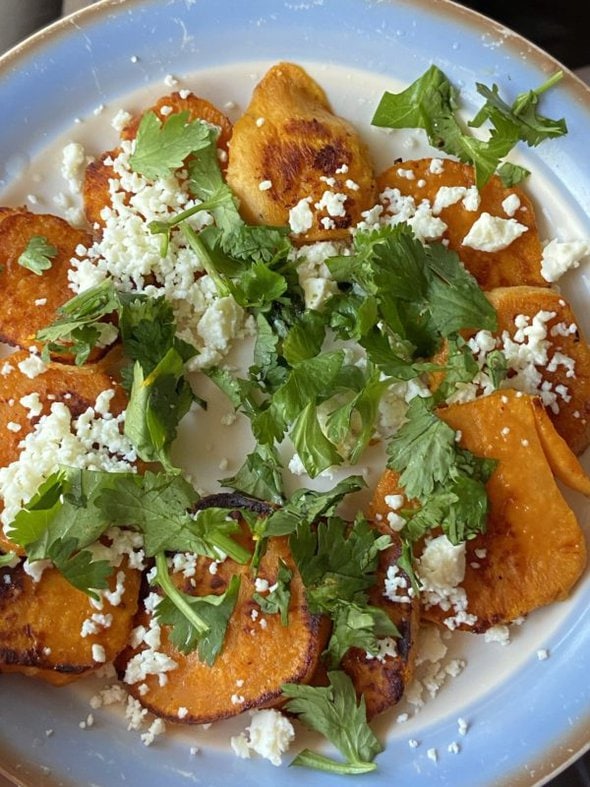
Or how I ended up making this one-person pasta dish.

I think the official name for use-what-you’ve-got approach is Reverse Meal Planning, but whatever you call it, it’s a good skill to have in your frugal toolbox.
Maryanne, I hope I understood your question and that this was helpful. Send feedback if further clarification is needed!
Alrighty, guys! Help Maryanne out by sharing how you keep your kitchen stocked.
P.S. This guest post from Kristin (of Going Country) might help anyone who is trying to grocery shop less often. Kristin is a veritable expert on this, since she lives literally in the middle of nowhere. Check out her 10 tips!

Wendy G
Saturday 23rd of November 2024
Reading through the messages, I think I may be unique in my method. Looking back at all the changes in life and family size, I realize that at each one, I did the same thing.
Let me start with I LOATH shopping, stores, crowds of people, small talk. Did I mention that I LOATH shopping?
In the past 5 years I have gone from a six person (all adults 19-78 yo) to 1 adult - me. With each change of family size, I used the same method. When an item was opened, I wrote the date on it. If it was an item that we used regularly, when the item was empty I calculated how many days it lasted. I do this with EVERYTHING. Food, laundry, cleaning supplies. It is now a habit. I know how many of everything I use in a given time period. I keep a list on my cell phone of my items I use and how long it lasts + how often to buy.
I am a creature of habit. I eat and buy the same things over and over. I eat mainly high protein (chicken, beef, pig, eggs, nuts) and high fat (cottage cheese, cheeses, avocados, oils, butter) products and supplement with veggies. Very few fruits. I keep a stock of most things and I know the store sale patterns. I will catch the best sales at the best price and buy 3-12 months supply. For instance: Sam's this month has Kerry Gold Irish butter, always November - I bought 60 lbs. This will last until next November. Aldi's has green beans on sale rock bottom prices. I bought enough to bring my stock pile back to 1 years worth. Both of these combined saved me approximately $100.
Did I mention I LOATH shopping? I keep a pantry stock of between 3 months - 2 years. I shop different patterns. Sam's club - I shop quarterly at the most. I live 70 miles from the closest Sam's Club. When it is time for the quarterly shop, I look back at my previous orders online (to trigger my memory) and reorder the same thing over and over. Depending on what it is, I will have it shipped. I will schedule for pick-up so that the non-perishables can be loaded in the car for me. Those items that I want to pick out myself I will run in and scan and go. THE LIST OF EVERYTHING I BUY IS AVAILABLE ONLINE OR ON THE APP AT ALL TIMES. Rinse and repeat.
I shop Aldi according to sales pattern. I buy the same thing all the time. I keep a checklist of those items on my cell phone Notes. When my favorite items go on sale at Aldi (following their sales pattern) I pick up enough for 6 weeks - 1 year depending on what it is and when it goes on sale. Anything that is checked on the checklist is bought at that time as well to bring me back up to my "stock level".
Occasionally I shop Kroger if they have the cheapest price/best quality. The same for Walmart. I use pick up service for both of these.
So I use many methods to ensure that I do not run out, but if I do it goes on the list and waits on my shopping pattern. If I run out, I update my "how many I use in X time period" and restock per my shopping pattern. It goes the other way as well. If I have too much of something the I adjust down accordingly.
This works very well for me because I LOATH shopping. I hope my method helps someone!
Jenny Young
Wednesday 20th of November 2024
My system is similar to Kristen's. I keep a list of menus (I keep mine in my head but I've cooked for a very long time) & keep those things on hand. Keep extras on hand as well...however much you can use up before it goes bad. For milk, (for example) I don't keep extra fresh milk but I do keep a can of powdered milk that I can mix up & use for cooking.
The easiest way to do that is every time you empty something...go write it on your shopping list. This way I don't run out of condiments, meats, sides, ect. There are things I buy every single week...fresh produce, a little dairy & eggs. So they just stay on the list. I keep the list in my pantry & as I cook a meal, I notice as I empty things or something is getting low & just add it to the list. I shop once a week. Before I go shopping I do a walk through, looking in the fridge, the pantry the big freezer for things I may have missed.
Another thing that helps me is to keep a simple menu routine. I have 5 to 7 meals we eat all the time so I always have those things on hand...baked tilapia on Sundays, a few different salads for summers & soups for winters. And I keep at least 3 throw-together choices on hand all the time too.
Jamie R.
Tuesday 19th of November 2024
Mostly, I cook for myself only, except for the holidays and also random baked goodies for everyone in my household. And I mostly cook from scratch and have regular meals and recipes on rotation. I nearly always cook in bulk, enough for several meals. I make lentil and sweet potato stew and freeze most of it. I roast a lot of veggies in the cooler weather and marinate a lot of veggies in the warmer weather. Really, I marinate all year round. So I shop seasonally, mostly traveling on public transportation, and keep everything on my digital list (Our Groceries, which can be accessed by phone app or computer or text or printed), and keep lists by store and by recipe there. I like that when I cross off a grocery item, it goes to the bottom of the list, so I don't have to write it next time but I can just uncross it. When there's a sale, I use my deep freezer to stock up a bit. I use baskets inside to keep from losing things and have a bit of an inventory system that I'm not on top of, but generally I have a sense of what's in there and where it is. I also have a sense of what's in my cabinets, but there I keep a dry erase post-it inside the door to note things I've got multiples of so I don't overbuy. I shop from the freezer, especially when funds are low, time is short, and it's not farmer's market day. And if I buy anything that's extra perishable, like mushrooms, or berries, or cucumbers, I deal with it right away (berries), or within two days; I either wash/clean, and slice up and refrigerate or bag and freeze, or marinate, or cook to add to a dish I know I'll be making within the week. That has saved many a mushroom!
Suellen
Tuesday 19th of November 2024
For about six weeks now I've been trying to eat down the freezers (3) fridges (2, but one holds only bottled water currently), and the pantry. I've been creative with breakfast, eat lunch at work (avoiding the vending machine there), and snack for dinner (i work nights). It's forced me to work with what i already have, and 6 weeks without fast food saves money and is healthier.
Jen in Santa Cruz
Tuesday 19th of November 2024
Great tips, everyone! So to make sure I use things up, I am constantly reorganizing the frig so that my husband and teen son can see the foods front and center. I label leftovers, too, so they can tell right away what it is.
I love a stocked pantry but I also buy "weird" things on sale sometimes. So once in the summertime and usually in January I do a Use-It-Up challenge to use up the bits and bobs.